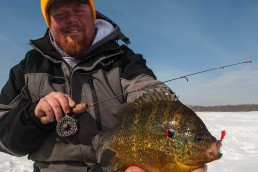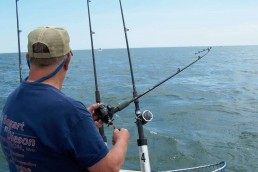November: Mining the Most of a Great Month
SHARE THIS POST
When I was younger the cold used to bother me quite a bit more than it does now. There is no doubt that November can be a pretty chilly month. Perhaps my tolerance now is a combination of becoming acclimated to lower temperatures, by just being “out” over the decades and the many improvements in outdoor clothing. Lately, I have been wearing IceArmor clothes, gloves and boots while ice fishing and have been pretty comfortable.
There are quite a few activities to bring a sportsman outside during this great fall month and certainly one is to try and shoot a whitetail during gun season. In my own state, hunters are allowed to use straight-walled pistol cartridges in centerfire rifles for the second year in a row. This adds a whole new dimension to an already great sport, and I am looking forward to downing at least one deer with my lever-action .44 magnum.
Throughout most of the Upper Midwest, the cold temperatures of November will have created ice sheets on farm ponds and ice on public lakes thick enough to support ice fishing. If the ice is at least 4 to 5 inches it should be sufficient, however, I prefer 6 to7 inches, just to be doubly safe. Remember, this is early-season ice and always think safety, safety, safety. Go with one or more buddies, take along cellphones and throw a Frabill Safety Kit in with your gear. This consists of ice spikes for your boots, ice grippers to wear around your neck until you need them and a loud whistle on a lanyard—very handy. Then, it is time to break out the rods, reels and spud or auger. Dress warmly, pour some coffee, tea or hot chocolate into a Thermos, and hit the ice. Take along a camera to record your catch.
How to begin? Drill holes and drop a treble-hooked sinking lure until it hits the bottom. Pull it up, and if it sprouts greenery on the trebles, begin there. The weeds signify plant growth, which in turn signifies oxygenated water and the likelihood of baitfish, panfish and larger predatory fish.
Attach a tiny bobber to your line, drop a tiny jig tipped with a waxworm or a piece of red worm, jiggle the offering occasionally and wait. When the bobber moves—even if it is the tiniest of movements—take up any slack and be ready to set the hook.
No luck? Try deadsticking—just let the bait sit still in the water. Better yet, drop a spoon such as a Tingler or a Little Cleo baited with a minnow on one line, and dead stick a minnow or worm on the other. The deadsticked rod should be reeled a few feet higher than the rod to be jigged. Every once in a while, just tap the deadsticked rod. Fish that are 20 feet away or so may not see the lower rod, but they will spot the dead stick and attack it. Sometimes that is all it takes to tempt the fish into biting.
Are you enjoying this post?
You can be among the first to get the latest info on where to go, what to use and how to use it!
Still no luck? Vary your depth, try a different jig, and when all else fails, drill some more holes in a different location. Above all, remember that the fish are there and they will bite. Don’t give up.
Over the past decade or so I have become increasingly interested in primitive hunting. This crisp fall month is a good time to get the muzzle-loading rifles and/or smoothbore out of the closet and give them a good going over. Flintlock rifles need this especially because it has many places for the corrosive effects of black powder to do its damage. Remove the lock and use Q-tips and an old toothbrush to remove any rust or powder build-up. Then cover it with a light coating of Bore Butter. Run a few patches down the barrel and coat it in the same way. Give the surface of the barrel a light coating of good gun oil and you should be all set. Never set it on its butt in the closet, rather, hang it horizontally so that any coating in the barrel will not migrate to the breach and cause a build up of residue. A good habit to get into is to repeat this procedure every six weeks or so, so that your guns can last a lifetime and be passed on to someone else.
The number of rabbits in the Midwest doesn’t equal the numbers found in the ‘50s and ‘60s, but there still are rabbits to hunt. Once the deer gun season is past (hope you put one in the freezer), call a buddy or two, secure permission from some land owners and hit the woods for some fun hunting.
There are three productive ways to locate rabbits: look for tracks in the snow; look for chewed bark on saplings (if the winter is bad), especially those located on the edges of woodlots; or look for rabbit droppings. If you find all three, you should be in for some good shooting. Any shotgun will do for rabbit hunting, if it is used well. Also, any shot size will work but most hunters seem to prefer #6 or #7 1/2. It doesn’t take large shot to knock over a rabbit, just a well-placed shot.
Okay, what’s there to do when it is cold, windy and rainy? Stay in, read MidWest Outdoors, watch The Weather Channel and prepare for your next chance to get out and spend some time in God’s great outdoors.
MWO
SHARE THIS POST
Did you enjoy this post?
You can be among the first to get the latest info on where to go, what to use and how to use it!
John Bennett
John Bennett is a retired history teacher, historical re-enactor, father and grandfather. As a four-season outdoorsman, his passion is waterfowl hunting and fishing for smallmouth bass. He lives in Ohio and spends quite a bit of time in his primitive log cabin, which he built.



